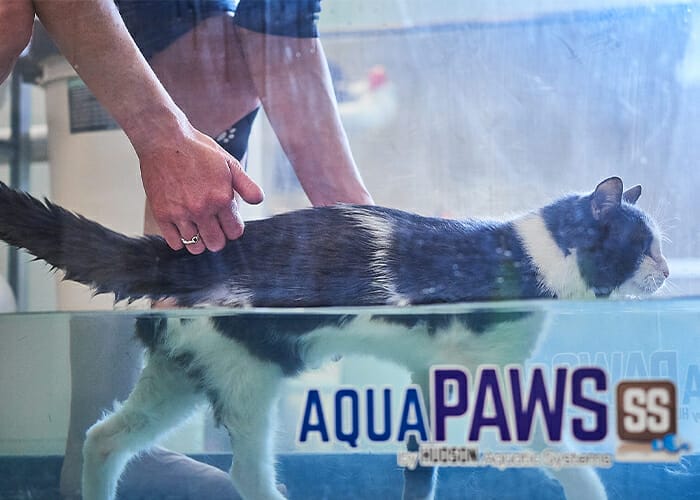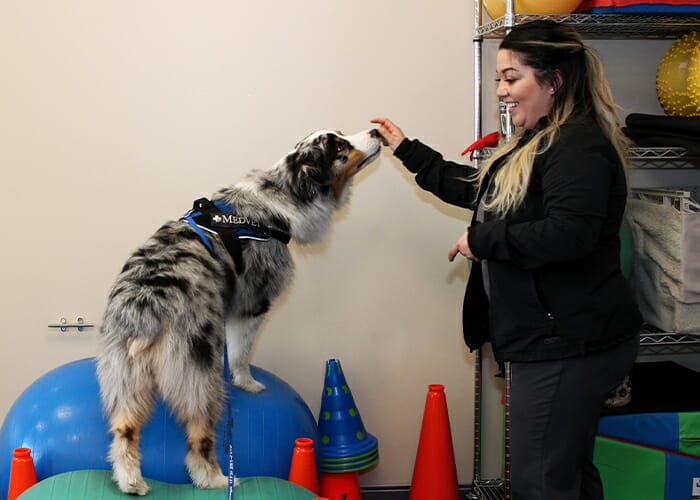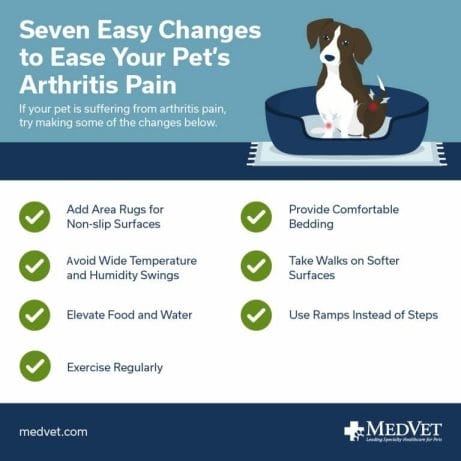Anesthesia & Pain Management, Integrative Medicine, Rehabilitation, Surgery
Tips for Managing Arthritis in Cats and Dogs

The most common form of arthritis in cats and dogs is osteoarthritis. This is a degenerative joint disease where the cartilage that surrounds and protects the joints progressively deteriorates. Osteoarthritis is typically seen more in older pets, although any pet can develop the condition. It’s estimated that about 20% of dogs over the age of 7 and 90% of cats over age 12 will exhibit signs of arthritis. Arthritis can be also be caused by infections or immune system issues.
As pets age, they can experience osteoarthritis in weight bearing joints such as knees, hips, and elbows. The spine can also experience some arthritic change leading to discomfort and decreased mobility.
Besides age, there are other factors that increase the chances of developing arthritis. Pets that have pre-existing conditions such as hip or elbow dysplasia or previous injuries such as fractures or ligament tears are at a greater risk. Obesity can also predispose pets to arthritis where additional body weight increases stress on the joints.
Finally, there are certain breeds that are more prone to issues than others. For cats, Himalayans, Persians, Maine Coons, and Siamese may be more likely to develop it. Larger dog breeds such as German Shepherds, Great Danes, Labradors, Retrievers, St. Bernards, and Mastiffs may also have an increased risk.
What are the Signs of Arthritis in Cats and Dogs?
At first, you may not notice signs because many of them can be attributed to your pet aging and simply slowing down. Some pets are good at hiding any pain which can make it even more difficult for you to notice these changes. However, it may be easier to spot signs in the early morning, after lying down for a long period of time, and during bouts of cold weather.
Signs may include:
- Decreased level of activity. Your pet may not seem as interested in activities they enjoyed. You might notice a decreased desire to run or play, or an increase in time spent sleeping or resting.
- Grooming changes. A pet may lick, chew, or bite at the area where they are feeling pain. On the other hand, they may decrease grooming because the movements have become painful.
- Limping. You may notice your pet favoring a limb. This may be more noticeable when they first stand up and even out as they warm up or with prolonged exercise.
- Mobility issues. Your pet may have difficulty getting up, stiffness while walking, or problems getting into the car or going up and down stairs.
- Muscle atrophy. If your pet has started to refrain from as much activity, they may start to lose their muscle. You may notice a change in their overall muscle mass or that one leg appears skinnier than another.
- Posture changes. If the arthritis is affecting the spine, you may notice that your pet develops an abnormal posture or seems to be hunched over.
- Temperament changes. Your normally happy-go-lucky pet may get irritable or less social, even starting to nip or bite. This typically stems from the pain and discomfort they are feeling. You also may notice they no longer want to be picked up or held certain ways, or even pet in certain areas.

How do Vets Diagnose Arthritis in Cats and Dogs?
An accurate diagnosis starts with your veterinarian getting a history and performing a full physical exam. As part of their exam, they will test range of motion and palpate the joints. This simply means they use their hands to feel around the joints for swelling or inflammation and assess the location and severity of pain. Your pet may also get radiographs (X-rays). These can help rule out other conditions that could be causing joint pain and determine the extent of damage to the joint.
What Treatments are Available for Pets with Arthritis?
Unfortunately, there is no cure for osteoarthritis. The goal of treatment is to slow the process down and alleviate your pet’s pain. There are several beneficial treatments to help your pet maintain an active, healthy, and comfortable lifestyle.
Pain Medications
Traditionally, arthritis treatment has focused on medication to relieve joint pain and inflammation. Nonsteroidal Anti-Inflammatory Drugs (NSAIDs) can reduce joint pain and decrease inflammation. It’s important to note that these must be formulated for your pet. Over-the-counter pain medications for humans can be very dangerous for your pet.
Supplements and Specialized Diets
In addition to medications, some joint supplements or specialized diets can be helpful. Certain supplements can support cartilage growth and increase water retention in cartilage to provide more cushioning for the joint. Diets with fatty acids may also help joint health.
Exercise
Exercise is key to improving your pet’s strength and fitness level, and in some cases, helping them lose weight. Not all exercises are equal. You’ll want to limit high-impact activities like running or jumping and instead opt for leash walks that can be calm and controlled. Low-impact and consistent exercise builds muscles around joints and can help your pet lose weight which helps decrease stress on the joints.
Rehabilitation
Some consider rehabilitation a tool that is reserved for pets recovering from surgery or injury, but the principles of rehabilitation medicine are universal. The overall goal is to improve comfort, joint motion, strength, and endurance so you and your pet can enjoy more active years together. Some of the different types of treatment include therapeutic ultrasound, cold or low-level laser therapy, electrical stimulation, therapeutic exercises, massage, or even an underwater treadmill.
Other Options
There are a variety of other treatment options including integrative medicine options like acupuncture, chiropractic care, novel electron conversion therapy, and stem cell therapy. In severe cases, your veterinarian can use surgical approaches to remove damaged tissue or even replace joints.

What Else Can Help a Pet with Arthritis?
In addition to medical treatment, there are some changes you can make around your home to help your pet be more comfortable.
- Add area rugs for non-slip surfaces. Hardwood, tile, and laminate floors are slippery and harder for your pet to walk on. Including rugs with non-skid backing can help your pet get sure footing inside the house. You can also use baby gates to restrict access to areas that have slippery surfaces. Keeping nails short can also be helpful.
- Avoid wide temperature and humidity swings. Cold temperatures can be harder for your arthritic pet to tolerate. Keeping them warm and dry can help alleviate pain. And it’s better for them to live inside than outside.
- Elevate food and water. Using raised food and water dishes can make it easier for your pet while eating and drinking.
- Exercise regularly. This helps your pet improve strength and lose weight.
- Provide comfortable bedding. Providing a soft surface for your pet to sleep and relax is also helpful. There are options available that provide orthopedic support or memory foam beds that help cushion your pet.
- Take walks on softer surfaces. Although walking is a great exercise for your pet, hard surfaces such as the sidewalk or a road may put more stress on their joints. Allowing your pet to walk on grass or dirt can help relieve discomfort.
- Use ramps. Providing a ramp to get into a car, onto furniture, or in place of steps allows your pet to still have independence to move around while making it more comfortable for them.

Living with Arthritis
Osteoarthritis, while not curable, can be a well-managed condition. With early detection and intervention, you can decrease your pet’s pain and increase their quality of life. If you notice symptoms or have concerns about arthritis in your pet, talk to your veterinarian. At MedVet, we’re also here to support you and your family veterinarian with integrative medicine, surgery, and rehabilitation services to enhance your pet’s quality of life.